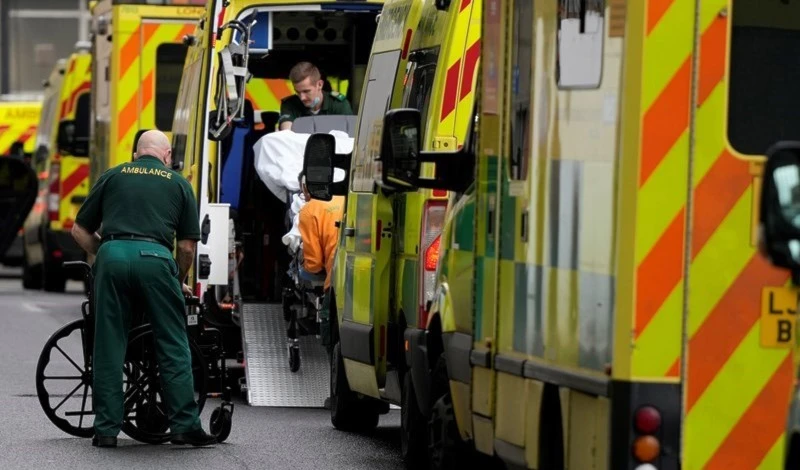2 million trapped in Gaza amid humanitarian breakdown
The UN warns that over 2 million remain trapped in Gaza as aid dwindles, infrastructure collapses, and mental health needs grow under the ongoing Israeli blockade.
-
 Relatives mourn over the bodies of several members of the al-Atal family, killed in an Israeli airstrike on a tent in the Jabalia refugee camp, before their burial at the Indonesian hospital in Beit Lahia, northern Gaza Strip, Thursday, April 17, 2025. (AP)
Relatives mourn over the bodies of several members of the al-Atal family, killed in an Israeli airstrike on a tent in the Jabalia refugee camp, before their burial at the Indonesian hospital in Beit Lahia, northern Gaza Strip, Thursday, April 17, 2025. (AP)
More than two million people remain trapped inside the Gaza Strip, the United Nations said Thursday, warning of a deepening humanitarian crisis amid relentless Israeli assaults and an Israeli blockade that has halted aid deliveries since early March.
“More than 2 million people remain trapped inside Gaza. Ongoing hostilities and dwindling aid supplies have driven up stress levels — especially among children — with mental health needs growing by the day,” said UN spokesperson Stephane Dujarric, citing the Office for the Coordination of Humanitarian Affairs (OCHA), according to Anadolu.
Aid supplies critically low since March blockade
The humanitarian crisis in Gaza has escalated sharply since "Israel" imposed a full blockade on cargo, including life-saving assistance, on March 2. Dujarric warned that current aid levels are critically low, further threatening public health and civilian survival.
The blockade has severely impacted essential infrastructure. “The water sector has been heavily damaged,” Dujarric noted, adding that nearly 90% of Gaza’s water assets have been affected by the ongoing war.
Gaza’s children struggle with trauma as genocide drags on
With children bearing the brunt of forced displacement, massacres, and resource shortages, the UN has reported a sharp increase in mental health needs across the enclave. Stress levels have surged in tandem with the deteriorating living conditions, compounding the crisis.
Dujarric reiterated the UN's position on international law, “We reiterate that Israel, as the occupying power, has clear obligations under international law, which include ensuring food, medical supplies, and public health services are available, and facilitating humanitarian relief when these are not otherwise supplied.”
In addition to the worsening situation in Gaza, the UN also highlighted ongoing displacement in the occupied West Bank. Thousands of residents in northern areas have been forced to flee due to continued Israeli military operations and remain unable to return to their homes.
As the Gaza humanitarian crisis in 2025 unfolds under a tightening Israeli blockade and ongoing Israeli bombardments, the UN continues to call for immediate access to aid and adherence to international humanitarian obligations.
Nearly half a million displaced in Gaza since March as crisis worsens
The humanitarian crisis in Gaza continues to escalate, with nearly half a million Palestinians displaced since March 18, according to the UN Office for the Coordination of Humanitarian Affairs (OCHA). This comes as the region faces mounting hardships.
In a statement released Thursday, OCHA said that most of the newly displaced individuals had already been forced to flee multiple times prior to the temporary ceasefire that began on January 19. The pattern of repeated displacement has significantly intensified the suffering of civilians and stretched Gaza’s fragile humanitarian infrastructure to the breaking point.
“Ongoing hostilities across the Gaza Strip continue to have devastating effects on civilians, including death, displacement and the destruction of vital infrastructure,” the agency warned.
Israeli airstrikes and repeated displacement
"Israel" resumed its aerial bombardment campaign in mid-March, triggering a new wave of mass displacement. Relief workers say many of the displaced have no access to proper shelter, with families in towns like Bani Suheila relying on fabric scraps and blankets to survive amid ongoing airstrikes.
The repeated displacement of Palestinians is compounding the existing crisis. Many of the 500,000 newly displaced had already moved multiple times since October 2023, reflecting the cyclical and cumulative toll of continued Israeli military operations in Gaza.
OCHA also condemned the severe limitations on humanitarian access, noting that on the day of its report, "Israel" only facilitated two out of six planned aid missions. “Israel rejected four other missions, including one intended to bring fuel from Rafah,” the agency said, without disclosing further details.
The agency emphasized that consistent restrictions on humanitarian deliveries—ranging from food and fuel to shelter and medical supplies—have pushed Gaza further into crisis. Since March, Israeli authorities have blocked the entry of essential goods, crippling efforts to stabilize the region.
Acute malnutrition and healthcare collapse
The UN report also highlighted a sharp rise in acute malnutrition in Gaza, particularly among children. The number of children receiving supplemental nutrition fell by more than two-thirds in March alone, as relief channels were choked by border closures and logistical barriers.
Meanwhile, Gaza’s healthcare infrastructure is nearing collapse. “Israeli restrictions are significantly hampering efforts to deliver medical supplies to hospitals,” the report stated. Medical centers already struggling with the influx of wounded now face critical shortages in both equipment and medication.
The intensifying displacement and collapse of basic services have led UN experts and human rights organizations to describe "Israel’s" policies as part of a broader campaign aimed at depopulating Gaza. Some have warned that these actions may amount to what they describe as a genocidal policy designed to clear the territory for occupation.
With humanitarian access throttled, malnutrition rising, and nearly half a million people displaced in under a month, Gaza’s humanitarian crisis in 2025 has reached a breaking point—one that the international community is increasingly ignoring.

 5 Min Read
5 Min Read









